Related Research Articles

Hamsters are rodents belonging to the subfamily Cricetinae, which contains 19 species classified in seven genera. They have become established as popular small pets. The best-known species of hamster is the golden or Syrian hamster, which is the type most commonly kept as pets. Other hamster species commonly kept as pets are the three species of dwarf hamster, Campbell's dwarf hamster, the winter white dwarf hamster and the Roborovski hamster.

Most United States presidents have kept pets while in office, or pets have been part of their families. Only James K. Polk, Andrew Johnson, and Donald Trump did not have any presidential pets while in office. However, Johnson did take care of some mice he found in his bedroom.
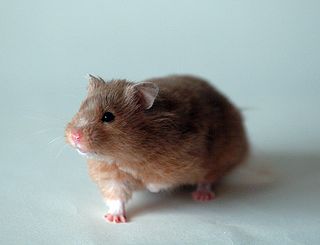
The golden hamster or Syrian hamster is a rodent belonging to the hamster subfamily, Cricetinae. Their natural geographical range is in an arid region of northern Syria and southern Turkey. Their numbers have been declining in the wild due to a loss of habitat from agriculture and deliberate elimination by humans. Thus, wild golden hamsters are now considered endangered by the International Union for Conservation of Nature. However, captive breeding programs are well-established, and captive-bred golden hamsters are often kept as small house pets. They are also used as scientific research animals.

Alice Lee Roosevelt Longworth was an American writer and socialite. She was the eldest child of U.S. president Theodore Roosevelt and his only child with his first wife, Alice Hathaway Lee Roosevelt. Longworth led an unconventional and controversial life. Her marriage to Representative Nicholas Longworth III, a Republican Party leader and 38th Speaker of the U.S. House of Representatives, was shaky, and her only child, Paulina, was from her affair with Senator William Borah.
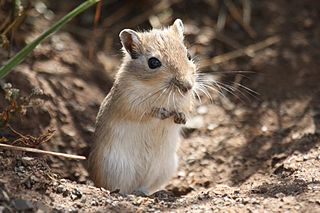
The Mongolian gerbil or Mongolian jird is a small rodent belonging to the subfamily Gerbillinae. Their body size is typically 110–135 mm, with a 95–120 mm tail, and body weight 60–130 g, with adult males larger than females. The animal is used in science and kept as a small house pet. Their use in science dates back to the latter half of the 19th century, but they only started to be kept as pets in the English-speaking world after 1954, when they were brought to the United States. However, their use in scientific research has fallen out of favor.

The winter white dwarf hamster, also known as the Russian dwarf hamster, Djungarian hamster, Dzungarian hamster, striped dwarf hamster, Siberian hamster, or Siberian dwarf hamster, is one of three species of hamster in the genus Phodopus. It is ball-shaped and typically half the size of the Syrian hamster, so is called a dwarf hamster along with all Phodopus species. Features of the winter white hamster include a typically thick, dark grey dorsal stripe and furry feet. As winter approaches and the days shorten, the winter white dwarf hamster's dark fur is almost entirely replaced with white fur. In captivity, this does not usually happen as animals maintained as pets are generally housed indoors and exposed to artificial light that prevents the recognition of short winter daylengths. In the wild, they originate from the wheat fields of Kazakhstan, the meadows of Mongolia and Siberia, and the birch stands of Manchuria.
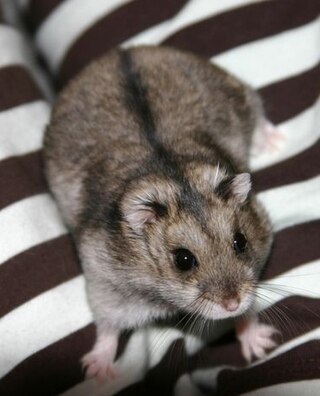
Campbell's dwarf hamster is a species of hamster in the genus Phodopus. It was given its common name by Oldfield Thomas in honor of Charles William Campbell, who collected the first specimen in Mongolia on July 1, 1902. It is distinguished from the closely related Djungarian hamster as it has smaller ears and no dark fur on its crown. Campbell's dwarf hamster typically has a narrow dorsal stripe compared to the Djungarian hamster and grey fur on the stomach. This hamster may be raised in captivity and kept as a small pet.

Kirk LeMoyne "Lem" Billings was an American businessman known for his close and long-time friendship with John F. Kennedy and the Kennedy family. Billings was a prep school roommate of Kennedy, an usher at his wedding and a campaigner for his successful 1960 presidential bid. Joseph Kennedy Sr. called him "my second son," and he sometimes acted as escort for several of the Kennedy women. Billings served with Sargent Shriver as a trustee for the Kennedy family trusts.
Lymphocytic choriomeningitis (LCM) is a rodent-borne viral infectious disease that presents as aseptic meningitis, encephalitis or meningoencephalitis. Its causative agent is lymphocytic choriomeningitis mammarenavirus (LCMV), a member of the family Arenaviridae. The name was coined by Charles Armstrong in 1934.

Phodopus, a genus of rodents in the hamster subfamily Cricetinae—a division of the larger family Cricetidae—is a lineage of small hamsters native to central Asia that display unusual adaptations to extreme temperatures. They are the only known hamsters that live in groups and, in some cases, rely on significant contributions by males to the raising of offspring. They are nocturnal and active throughout the year; they do not hibernate. Species of Phodopus, together with members of the genera Cricetulus, Allocricetulus and Tscherskia are called dwarf hamsters because of their small size relative to other hamsters.

The Roborovski hamster, also known as the desert hamster, Robo dwarf hamster, or simply dwarf hamster, is the smallest of three species of hamster in the genus Phodopus. It lives in the deserts of Central Asia, averaging 1.8 centimetres (0.7 in) at birth and 4.8 centimetres (1.9 in) and 12–24 grams (0.42–0.85 oz) during adulthood. Distinguishing characteristics of the Roborovskis are eyebrow-like white spots and the lack of any dorsal stripe. The average lifespan for the Roborovski hamster is 2–3 years, though this is dependent on living conditions. Roborovskis are known for their speed and have been said to run up to 6 miles a night.

A hamster wheel or running wheel is an exercise device used primarily by hamsters and other rodents, but also by other cursorial animals when given the opportunity. Most of these devices consist of a runged or ridged wheel held on a stand by a single or pair of stub axles. Hamster wheels allow rodents to run even when their space is confined. The earliest dated use of the term "hamster wheel", located by the Oxford English Dictionary, is in a 1949 newspaper advertisement.
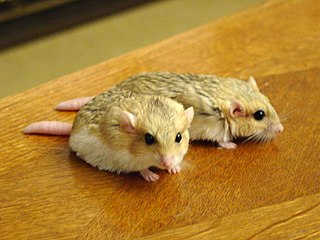
The fat-tailed gerbil, also called the duprasi gerbil or doop, is a rodent belonging to the subfamily Gerbillinae. It is the only member of the genus Pachyuromys. They are frequently kept as pets.

NASA Astronaut Group 5 was a group of nineteen astronauts selected by NASA in April 1966. Of the six Lunar Module Pilots that walked on the Moon, three came from Group 5. The group as a whole is roughly split between the half who flew to the Moon, and the half who flew Skylab and Space Shuttle, providing the core of Shuttle commanders early in that program. This group is also distinctive in being the only time when NASA hired a person into the astronaut corps who had already earned astronaut wings, X-15 pilot Joe Engle. John Young labeled the group the Original Nineteen in parody of the original Mercury Seven astronauts.
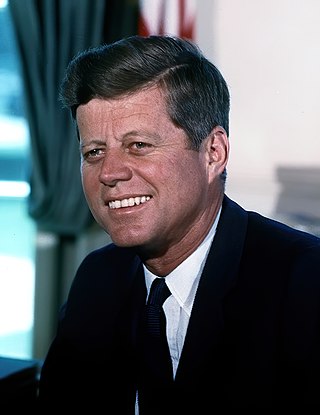
John Fitzgerald Kennedy, often referred to by his initials JFK, was an American politician who served as the 35th president of the United States from 1961 until his assassination in 1963. He was the youngest person to assume the presidency by election and the youngest president at the end of his tenure. Kennedy served at the height of the Cold War, and the majority of his foreign policy concerned relations with the Soviet Union and Cuba. A Democrat, Kennedy represented Massachusetts in both houses of the U.S. Congress prior to his presidency.

Hamster balls are hollow spheres made of clear plastic into which hamsters, gerbils, degus and other small rodent pets are placed, allowing them to run around outside their cages without the risk of running away or getting lost under furniture. They are designed to provide hamsters with exercise. Balls produce an audible rumble across most surfaces, making them easier to locate even when out of sight.

The Stand in the Schoolhouse Door took place at Foster Auditorium at the University of Alabama on June 11, 1963. George Wallace, the Governor of Alabama, in a symbolic attempt to keep his inaugural promise of "segregation now, segregation tomorrow, segregation forever" and stop the desegregation of schools, stood at the door of the auditorium as if to block the entry of two African American students: Vivian Malone and James Hood.

Pushinka was a dog who was given by the Soviet Premier Nikita Khrushchev to the President of the United States, John F. Kennedy in 1961. Pushinka was the daughter of Strelka, who had travelled into space aboard Korabl-Sputnik 2.

The domestication of the Syrian hamster began in the late 1700s when naturalists cataloged the Syrian hamster, also known as Mesocricetus auratus or the golden hamster. In 1930 medical researchers captured Syrian hamster breeding stock for animal testing. Further domestication led this animal to become a popular pet.

Gulf Hamstery was a hamstery which established the commercial Syrian hamster industry in the United States. It operated between 1946 through the early 1950s and was located in Mobile, Alabama.
References
- 1 2 "JFK's Hamsters, Debbie and Billie". Presidential Pet Museum. 19 March 2016.
- ↑ The laboratory rabbit, guinea pig, hamster, and other rodents. Mark A. Suckow, Karla A. Stevens, Ronald P. Wilson (1st ed.). London: Elsevier. 2012. pp. 747–753. ISBN 978-0-12-380921-6. OCLC 774295857.
{{cite book}}: CS1 maint: others (link) - 1 2 Saunders, Marya (26 July 1963). "From the White House: Please no more pets!". Sarasota Herald-Tribune .
- ↑ Bryant, Traphes (1976). Dog days at the White House : the outrageous memoirs of the Presidential kennel keeper. Frances Spatz Leighton. New York: Pocket Books. ISBN 0-671-80533-9. OCLC 3311531.